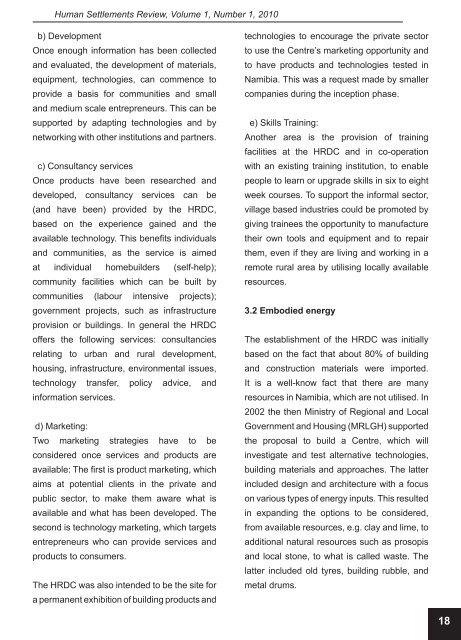Human Settlements Review - Parliamentary Monitoring Group
Human Settlements Review - Parliamentary Monitoring Group
Human Settlements Review - Parliamentary Monitoring Group
You also want an ePaper? Increase the reach of your titles
YUMPU automatically turns print PDFs into web optimized ePapers that Google loves.
<strong>Human</strong> <strong>Settlements</strong> <strong>Review</strong>, Volume 1, Number 1, 2010<br />
b) Development<br />
Once enough information has been collected<br />
and evaluated, the development of materials,<br />
equipment, technologies, can commence to<br />
provide a basis for communities and small<br />
and medium scale entrepreneurs. This can be<br />
supported by adapting technologies and by<br />
networking with other institutions and partners.<br />
c) Consultancy services<br />
Once products have been researched and<br />
developed, consultancy services can be<br />
(and have been) provided by the HRDC,<br />
based on the experience gained and the<br />
available technology. This benefits individuals<br />
and communities, as the service is aimed<br />
at individual homebuilders (self-help);<br />
community facilities which can be built by<br />
communities (labour intensive projects);<br />
government projects, such as infrastructure<br />
provision or buildings. In general the HRDC<br />
offers the following services: consultancies<br />
relating to urban and rural development,<br />
housing, infrastructure, environmental issues,<br />
technology transfer, policy advice, and<br />
information services.<br />
d) Marketing:<br />
Two marketing strategies have to be<br />
considered once services and products are<br />
available: The first is product marketing, which<br />
aims at potential clients in the private and<br />
public sector, to make them aware what is<br />
available and what has been developed. The<br />
second is technology marketing, which targets<br />
entrepreneurs who can provide services and<br />
products to consumers.<br />
The HRDC was also intended to be the site for<br />
a permanent exhibition of building products and<br />
technologies to encourage the private sector<br />
to use the Centre’s marketing opportunity and<br />
to have products and technologies tested in<br />
Namibia. This was a request made by smaller<br />
companies during the inception phase.<br />
e) Skills Training:<br />
Another area is the provision of training<br />
facilities at the HRDC and in co-operation<br />
with an existing training institution, to enable<br />
people to learn or upgrade skills in six to eight<br />
week courses. To support the informal sector,<br />
village based industries could be promoted by<br />
giving trainees the opportunity to manufacture<br />
their own tools and equipment and to repair<br />
them, even if they are living and working in a<br />
remote rural area by utilising locally available<br />
resources.<br />
3.2 Embodied energy<br />
The establishment of the HRDC was initially<br />
based on the fact that about 80% of building<br />
and construction materials were imported.<br />
It is a well-know fact that there are many<br />
resources in Namibia, which are not utilised. In<br />
2002 the then Ministry of Regional and Local<br />
Government and Housing (MRLGH) supported<br />
the proposal to build a Centre, which will<br />
investigate and test alternative technologies,<br />
building materials and approaches. The latter<br />
included design and architecture with a focus<br />
on various types of energy inputs. This resulted<br />
in expanding the options to be considered,<br />
from available resources, e.g. clay and lime, to<br />
additional natural resources such as prosopis<br />
and local stone, to what is called waste. The<br />
latter included old tyres, building rubble, and<br />
metal drums.<br />
18









![National Research Foundation Annual Report 2008 / 2009 [Part 2]](https://img.yumpu.com/49774036/1/177x260/national-research-foundation-annual-report-2008-2009-part-2.jpg?quality=85)







